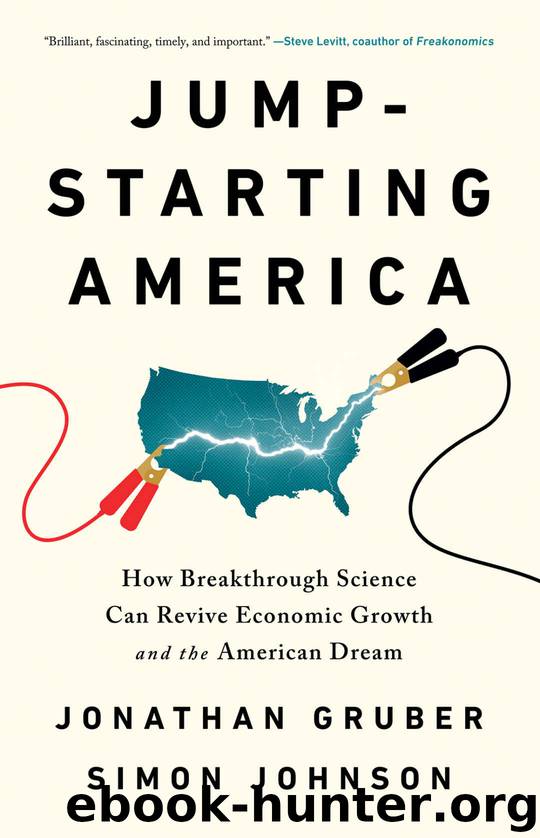Jump-Starting America by Jonathan Gruber & Simon Johnson

Author:Jonathan Gruber & Simon Johnson [Gruber, Jonathan]
Language: eng
Format: azw3, epub
Publisher: PublicAffairs
Published: 2019-04-09T04:00:00+00:00
USING AN INDEPENDENT COMMISSION
A major issue that will be raised with such a new large commitment is governance. How do we make sure this does not turn into a congressional (or executive branch) boondoggle, with funds handed out as political favors rather than rewarding the most deserving research projects?
We agree that this is a serious issue. It is critical that this new program be administered through a new independent entity that is not part of either the administration or Congress. It should follow the structure of the Base Realignment and Closure (BRAC) Commission, which has, over recent decades, successfully reduced the number of military bases.
The BRAC is an underappreciated mechanism for making the kind of hard decisions that seem to constantly bedevil our paralyzed and polarized Congress. Following the end of the Cold War, the United States realized it had substantial excess military real estate but that it would be hard to shutter this capacity since elected politicians have a strong parochial incentive to keep local bases active. The BRAC process was introduced to address this problem in 1988, with rounds in four subsequent years, the most recent being 2005.
The BRAC Commission consists of nine members appointed by the president. The Department of Defense presents this commission with a list of bases to be closed, and the commission reviews and modifies this list before presenting it to the president. Along the way, there is substantial scope for public input to the process, with the 2005 committee hearing from hundreds of public officials and receiving around two hundred thousand pieces of mail from private citizens. All nonconfidential information and proceedings were provided to the public, and each site on the list had to be visited by at least two members of the commission. If the president approves, the full set of changes goes into effect—unless the entire list is rejected by Congress.
In a world where it is hard to take on entrenched interests, the BRAC Commission was an unqualified success. These rounds resulted in the closure of more than 350 installations that were no longer necessary.
BRAC is our model for the creation of an Innovation Commission (IC) that would make recommendations to Congress for areas that would receive funding to establish the new hubs. The commission would make a recommendation on which Congress could vote up or down, but with a presumption of acceptance. This commission would be fully transparent in all its work. Commissioners would be appointed for a fixed period of time and would be charged with generating a financial return for society as a whole—in the form of an innovation dividend, discussed later. This financial return will provide a clear measure of whether the commission does its job properly.
To remain both politically viable and economically productive, the Innovation Commission has to address head-on the issue of failure. While, as we have shown, there are high returns to science-based investments, there are also high risks. The real benefit comes from a small number of investments yielding extraordinary returns. Recall
Download
Jump-Starting America by Jonathan Gruber & Simon Johnson.epub
This site does not store any files on its server. We only index and link to content provided by other sites. Please contact the content providers to delete copyright contents if any and email us, we'll remove relevant links or contents immediately.
The Secret History by Donna Tartt(16622)
The Social Justice Warrior Handbook by Lisa De Pasquale(11489)
Thirteen Reasons Why by Jay Asher(7788)
This Is How You Lose Her by Junot Diaz(5770)
Weapons of Math Destruction by Cathy O'Neil(5036)
Zero to One by Peter Thiel(4824)
The Myth of the Strong Leader by Archie Brown(4789)
Promise Me, Dad by Joe Biden(4447)
Beartown by Fredrik Backman(4415)
Stone's Rules by Roger Stone(4415)
How Democracies Die by Steven Levitsky & Daniel Ziblatt(4398)
The Fire Next Time by James Baldwin(4342)
100 Deadly Skills by Clint Emerson(4076)
A Higher Loyalty: Truth, Lies, and Leadership by James Comey(4032)
Rise and Kill First by Ronen Bergman(4012)
The David Icke Guide to the Global Conspiracy (and how to end it) by David Icke(3881)
The Farm by Tom Rob Smith(3872)
Secrecy World by Jake Bernstein(3782)
The Doomsday Machine by Daniel Ellsberg(3730)
